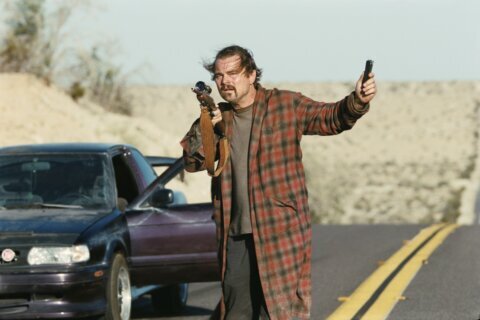WASHINGTON – From Navy SEAL memoir to hit novel.
From hit novel to the silver screen.
“Lone Survivor” recounts the true tale of Marcus Luttrell, the lone survivor of Operation Red Wings, an ill-fated mission to take out Taliban leader Ahmad Shahd in Afghanistan circa June 2005. For those keeping track, this was the same time that Kathryn Bigelow’s “Hurt Locker” boys were defusing roadside bombs in Iraq, while her “Zero Dark Thirty” heroine was busy tracking down Osama Bin Laden with equal bits tradecraft and determination.
Four members of Navy SEAL Team 10 are dropped into the steep, jagged mountains of Sawtalo Sar, Afghanistan, including Luttrell (Mark Wahlberg), Lt. Michael Murphy (Taylor Kitsch), Gunner’s Mate Danny P. Dietz (Emile Hirsch) and Sonar Technician Matthew “Axe” Axelson (Ben Foster). The men are jacked up and tough as nails with the camaraderie of a true “band of brothers,” but an air of uneasiness hangs over the mission.
“It’s feeling like a cursed op,” one of the SEALs says.
“No curses. It’s just Afghanistan. That’s all,” Marcus replies.
Tell that to the Brits and the Soviets.
Before long, things start going wrong. Their walkie talkies fail. A herd of goats introduces them to a group of Afghan shepherds. A massive gun battle erupts. And the SEALs tumble down the mountain. And they tumble down the mountain. And they tumble down the mountain again.
You know how this one ends purely from the title, and rest assured, it’s not for the weak of stomach. Yet even though we know the ending, director Peter Berg (“Friday Night Lights,” “The Kingdom”) creates some of the most intense war action ever put on film. Daring stuntmen bounce off rocks and slam into trees. Bullets rip through bodies with splattering exit wounds. Every bump, bruise, gash and protruding bone is shown in gruesome detail, culminating in a soldier’s slow-motion death on two knees that recalls Willem Dafoe’s demise in “Platoon” (1986).
The music and cinema-verite (almost documentary) style will remind of you of Berg’s “Friday Night Lights,” while the gruesome reality will shock audiences the way the Omaha Beach scene did in “Saving Private Ryan” (1998). But that’s where the “Private Ryan” comparisons stop.
“Lone Survivor” has a powerful true story, but the script lacks the narrative depth of “Private Ryan.” Tom Hanks led a deeply human mission to save a World War II soldier, protecting a mother from the grief of losing all of her sons. This was set up by George Marshall reading a letter from Abraham Lincoln, proving that sometimes basic humanity trumps war strategy. But it was also questioned by soldiers who debate whether it’s worth risking all of their lives to save just one. By the time Hanks told Matt Damon, “Earn this,” we were in a pool of tears because the film connected on both levels: the superficial level of visceral thrill ride, and the deeper level of moral commentary.
“Lone Survivor” is mostly surface. A jagged, rocky surface that we bounce off hard whilst losing our appetite for popcorn. We see the characters’ bones protrude, but we see very little of “what’s on the inside.” You could say it’s a “Tale of Two Bergs,” as Peter Berg ferociously explores the tip of the iceberg, but forgets there’s a glacier a mile deep that could have been examined beneath the surface.
Thus, a better comparison is “Black Hawk Down” (2001), both true tales of failed U.S. missions with Mark Wahlberg more on the skill level of Josh Hartnett than Tom Hanks. “Black Hawk Down” and “Lone Survivor” will both have their niche followings. And they should. They’re both good movies. Just don’t expect either to make the AFI’s Top 100 list like “Private Ryan.”
I watched “Lone Survivor” riveted by the action, but yearning to know the characters. We see brief glimpses of their personal lives in Act One, where a SEAL instant-messages his girlfriend about buying a horse as a wedding present. But we never feel as emotionally invested in Wahlberg as we did with Jeremy Renner in “The Hurt Locker” (2008) or George C. Scott in “Patton” (1970).
The closest we come is a moral debate over how to handle the surprise Afghan shepherds. Should the SEALs kill innocent civilians? Or should they let them go, knowing full well that they could tip off the Taliban militants? To me, this was the most fascinating part of the movie, similar to the four men in “Deliverance” (1972) debating how to handle their own wilderness morality play.
Unfortunately when the shooting starts, we never return to such deep moral questions. In fact, we must wait until the end credits to see an explanation of the Pashtunwali ethical code — an element that would have been better explored within the actual film. Instead, it feels like something that a producer suggested after the fact: “Umm, Peter, you might want to explain the motives of the villagers.”
It’s a small symptom of a much larger lack of purpose. The film is a lot like the Afghanistan War itself, filled with valiant efforts under leaders who have a murky vision for what they’re trying to accomplish. Sure it’s a realistic portrayal of this specific mission. But to what end?
Not every film has to be “Lawrence of Arabia” (1962), which explained how the Middle East got carved up in the first place. But to become a 4-star war flick, you must offer some sort of broader examination of the nature of war, as did “The Deer Hunter” (1978), “Apocalypse Now” (1979) and “Full Metal Jacket” (1987). The closest we come here is an NYFD patch on a T-shirt. Berg is on the right track, with echoes of 9/11, but there’s no broader attempt to contextualize it.
Compare this to the year’s other Navy SEAL true story, “Captain Phillips,” which explored the emotions of both the U.S. cargo captain (Tom Hanks) and the Somali pirate captain (Barkhad Abdi). While the pirates were the film’s antagonists, we at least got a window into their motivation: desperation fueled by globalization. They were fully fleshed characters, while “Lone Survivor” offers cookie-cutter bad guys who keep a-‘comin’ like zombies in a “Call of Duty” video game.
And so, “Captain Phillips” is nominated for Best Picture and “Lone Survivor” isn’t. The biggest thing the latter has going for it are its first five words: “Based on a True Story.” But if you took the same script and made a purely fictional movie out of it, it wouldn’t have the same power. And therein lies the problem. The true story is heroic. The screenplay is hollow.
For all this, I can’t bring myself to call it a “great movie.” But this isn’t “Short Term 12.” It’s Seal Team 10. “Lone Survivor” is a fine tribute to the men and women who serve. I dare you not to feel humbled by the opening documentary footage of actual SEALs in training, just like I dare you not to get misty-eyed during the closing montage of fallen soldiers set to a cover of David Bowie’s “Heroes.” These guys are heroes. These guys are selfless. These guys are the best of the best.
In this way, “Lone Survivor” fulfills its narrow objective. It forces viewers to walk a mile in soldiers’ boots at a time when so few Americans are actually invested in a war that’s now entering its 13th year. Gone is the draft. Gone are the rubber drives. The Victory Gardens. The notion that when our nation goes to war, everyone should have skin in the game. Two of my closest college buddies served after 9/11, one in Iraq and one in Afghanistan, and I worry that each ballpark standing ovation feels like lip service when so many folks forget the war is still happening. And that’s the real tragedy. “Lone Survivor” is a smack in the face. It’s a reminder that flesh and blood is still on the ground beneath the drones. These brave souls are still on the front lines.
★ ★ ★
The above rating is based on a 4-star scale. Follow WTOP Film Critic Jason Fraley on Twitter @JFrayWTOP, read his blog The Film Spectrum or listen Friday mornings on 103.5 FM.
Follow @WTOP on Twitter.








